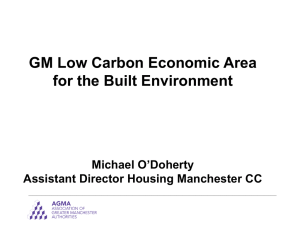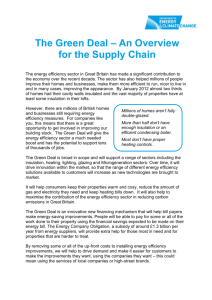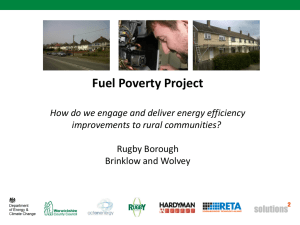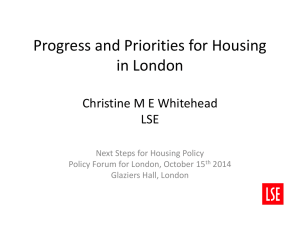Chapter 8: Warmer Homes Lower Bills
advertisement
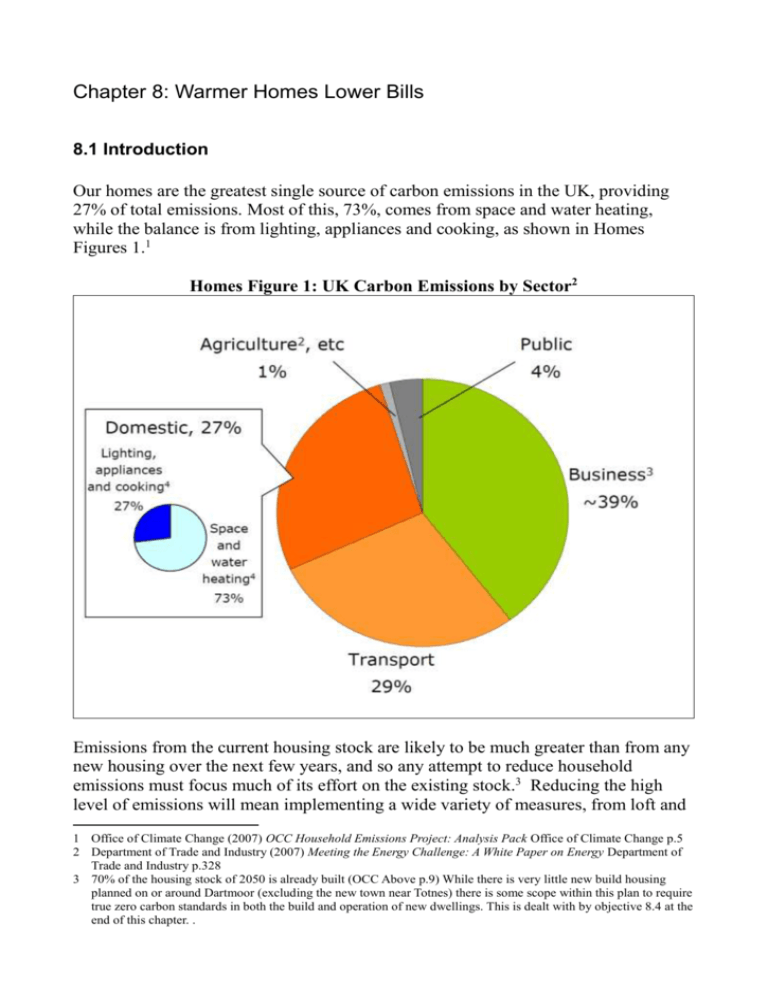
Chapter 8: Warmer Homes Lower Bills 8.1 Introduction Our homes are the greatest single source of carbon emissions in the UK, providing 27% of total emissions. Most of this, 73%, comes from space and water heating, while the balance is from lighting, appliances and cooking, as shown in Homes Figures 1.1 Homes Figure 1: UK Carbon Emissions by Sector2 Emissions from the current housing stock are likely to be much greater than from any new housing over the next few years, and so any attempt to reduce household emissions must focus much of its effort on the existing stock.3 Reducing the high level of emissions will mean implementing a wide variety of measures, from loft and 1 Office of Climate Change (2007) OCC Household Emissions Project: Analysis Pack Office of Climate Change p.5 2 Department of Trade and Industry (2007) Meeting the Energy Challenge: A White Paper on Energy Department of Trade and Industry p.328 3 70% of the housing stock of 2050 is already built (OCC Above p.9) While there is very little new build housing planned on or around Dartmoor (excluding the new town near Totnes) there is some scope within this plan to require true zero carbon standards in both the build and operation of new dwellings. This is dealt with by objective 8.4 at the end of this chapter. . cavity wall insulation to solid wall insulation for hard to treat homes. There will also be a need to look at alternative heating fuel options for homes not on the gas grid, and which currently use heating oil. Of all the different opportunities, loft and cavity wall insulation is the most significant, because there are a large number of eligible properties, it is comparatively cheap and has fast payback (as shown in Homes Figure 2), and there is an existing mechanism for delivery. . Home Figure 2: Non-Financial Reasons for Low Uptake of Energy Efficiency Measures 7 8.2 Barriers to Installing Fuel Efficiency Measures in Homes. There are several barriers to increasing uptake of efficiency measures. These are: limited data; cost (and lack of awareness of schemes, grants and discounts which can reduce it) and a range of non-financial barriers, including lack of knowledge of the benefits of insulation. This section looks at them in turn. 8.2.1 Limited data as a barrier to increasing energy efficiency in homes No information is yet available which identifies the individual houses requiring insulation on Dartmoor4, or which households are likely to be prepared to install it. 7 OCC (above) p.10 4 As Chapter 3, Where is Dartmoor says, “Dartmoor” for the purposes of this plan includes the moor’s surrounding towns and their hinterlands. So far as Dartmoor and the surrounding area are concerned, there is a need for comprehensive GIS mapping, ideally based on aerial photography supplemented by a house to house survey. Once prepared, the maps and the database which underpins them can be interrogated, to identify which households should be approached regarding a particular initiative. 8.2.2 Cost as a barrier to uptake to increasing energy efficiency in homes. For many people, cost is not a barrier to take up of energy efficiency measures. Draught-proofing and insulating a water tank usually costs only a few pounds. Loft and cavity wall insulation costs only a few hundred pounds. Grants are often available, dependent on age and income. These mean that loft and cavity wall insulation is currently free to everyone across most of Dartmoor who is over 59, on qualifying benefits, or where the combined total household income is less than £18000 per year.5 Even the associated costs of a loft hatch, core vents, additional area to be insulated, and access equipment can be reduced for people in these groups. The most anyone else is asked to contribute is £150 towards loft insulation and £170£200 for cavity wall insulation. There are two difficulties, however. The first is that (if the national trend applies in Devon) some eligible people do not apply for free grants, because they do not wish to be means tested. . This is particularly true of older people, who often find means testing intrusive and demeaning, but this is arises from a misunderstanding, since there is no means-testing for people over 70 in Devon.6 The funding may also fail to reach many younger people with families, who consequently fall into fuel poverty. Also, the grants do not pay for some associated costs, such as the cost of emptying a loft. This is important – some older people need help to empty their loft, and if it is not available, can not take up an insulation grant. The cost barrier is more serious in the case of insulation for solid walled properties, which form 33.4% of housing in Devon as a whole (and perhaps up to 50% whithin Dartmoor National Park). This is very expensive, with a very long payback period, which can be up to 13 years. There are no grants for such insulation on or around Dartmoor,6 despite the fact that nationally 50% of people who are fuel-poor live in such hard to treat dwellings. A household is considered to be in fuel poverty where over 10% of the household income is used on heating. Data from the CSE 2008 Fuel Poverty Indicator suggests there were 18,921 houses in fuel poverty within Devon (excluding Plymouth and 5 In North Devon, people aged under 70 and in households with a total income below £18000 per year need to contribute £99 towards the cost of both cavity wall and loft insulation. www.cosydevon.co.uk 6 Help the Aged (2008) Fuel Poverty: Help the Aged Policy Statement 2008 Help the Aged 6 Warmfront” is a government scheme which provides grant funding to householders who are eligible because of age, or sickness and disability, and are also in receipt of income-related benefit. Warmfront grants may be used for loft and cavity insulation and the installation of efficient heating systems. Torbay), but this is based on data taken at low point of energy costs (2001 and 2003), and so true figure likely to be far higher now). . This is a higher than average incidence, as a result of a higher than average proportion of pensioner households, and of homes which are “hard to treat” and are occupied by people on lower than average incomes.5 , The proportion is likely to be even greater on Dartmoor, because there are many homes which are off the gas grid, and heating oil is expensive. It is estimated that twice as many people in oil-heated homes are in fuel poverty as those in other homes, and such homes may represent 15% of the housing stock. The other approach to reducing household carbon emissions, apart from installing insulation and addressing other issues such as draught proofing and heating controls is to provide a renewable energy alternative. The most common, and often most cost effective, alternative is solar hot water. Such installations have a comparatively high capital cost and the repayment period varies considerably according to the level of hot water use (especially in the summer) and the type of fuel it replaces. The result is that many householders are understandably reluctant to pay the high initial capital cost for a renewable installation, even if they have could find the money, which most would find difficult. Also, renewables are not suited to all houses. Solar, for example, depends on unimpeded access to sunlight, and in a conservation area or on a listed building requiring planning consent. While cost can be a very serious barrier, it is at least matched in severity by the nonfinancial barriers. 8.2.3 Non-Financial Barriers to Increasing Energy Efficiency in Households One of the principal reasons people do not consider energy efficiency measures is that they are not very aware of their electricity and gas costs. Bills may be estimated or actual, and are often difficult to read. Even where people are aware of the cost of their electricity and gas, however, they may have other reasons for not acting. These can vary according to the social group to which people below, as shown in Home Figure 3. 5 Devon Local Strategic Partnership(2007) Devon Local Area Agreement 2008-2011: Reducing Fuel Poverty Home Figure 3: Non-Financial Reasons for Low Uptake of Energy Efficiency Measures 7 The Energy Savings Trust (EST) Devon programme targets the first three of these groups, and section 8.3.2 proposes a partnership with EST to increase the amount assistance available to each, adapting the offer to meet their concerns. It would also be possible to refine the approach using the Experian MOSAIC detailed classification scheme, which is already used by Energy Action Devon for its Cosy Devon marketing Some people have concerns other than those on the above list. For example, older people, and those who feel vulnerable at home may be reluctant to allow anybody into their property, or need to move items stored in the loft before any insulation can be done, and may find this very difficult to do. There is scope for discussion with Home Improvement Agencies to see whether help with loft clearance could be delivered by them. Alternatively, volunteers in each community might be able to help. The non-financial impediments mentioned here is not an exhaustive list. For example, external solid wall insulation will need planning consent for listed buildings, and perhaps other homes within the Park. The activities proposed in the next section will be delivered taking these other factors into account. 7 OCC (above) p.12 8.3 Solutions: Helping People Undertake Energy Efficiency Measures in Their Homes The effectiveness of the majority of energy efficiency measures means that it is well worthwhile trying to overcome the difficulties outlined in the previous section. There are a number of solutions which would do this, and they are discussed below. 8.3.1 Gathering Detailed Data The lack of information about which houses need insulation and other measures, and which householders are most likely to accept it, can be addressed through door to door surveys. This is, however, very labour intensive, particularly in rural communities. For this reason, it would be best to begin by undertaking aerial mapping. Digital photography can be used, with the results entered into a database which holds information on the average age of properties. Social indicators, from census returns or from providers such as Experian, can be entered into the database. Energy consumption data, if made available by energy companies, can also be added. When these three sets of data are combined, GIS maps can be generated showing housing blocks by age and type, overlaid with information on the propensity of occupiers to accept insulation and other measures. The age of dwellings is important, as Figure Homes 2 shows – and any programme to reduce emissions needs to be adapted to offer solutions appropriate to each housing type. This will provide a good initial dataset, but the information needs to be validated. This can only be done by visiting householders, starting with those who are shown by the GIS data as most promising. In some communities, and to a limited degree, this door-to-door survey work can be undertaken by volunteers. This is very valuable, but for more comprehensive coverage, especially in rural areas, paid workers are more appropriate. This would only be feasible if it were undertaken as part of a subsidised job creation scheme such as the Future Jobs Fund. Dartmoor Circle Limited has expressed interest in delivering 22 jobs under this fund and is exploring whether they may be recruited to undertake this survey work. The authors have not been able to identity any work done in another rural area on such a scale, or in such detail. It would, therefore, provide a useful case-study, which other areas could learn from. The data would also be very useful to district councils, poverty action groups, and others. For all these reasons, Dartmoor Circle proposes, with support from partner agencies, to create a footprinting resource able to undertake this work and to make the results widely available. Homes Figure 2: Profile of Energy Performance in Existing Dwelling Stock, 20044 8.3.2 Solutions to Lack of Finance for Energy Efficiency Measures. So far as people in fuel poverty are concerned, any solution requires a partnership between both installation and grant providers, on the one hand, and health providers 4 OCC (as above) p.9 and older people's representatives on the other. This is because the former need help to increase uptake of their services, while the latter can reach people in fuel poverty and supply some financial support. Help the Aged, in particular, has expertise in assisting older people to access unclaimed benefits, which can help people maximise the funding available to them. Once all those partners have agreed to support a programme in a particular locality, the authors believe it would be useful to fund older people in that area to act as ambassadors, and helping their peers to obtain insulation and other measures.8 The suggested link with state health providers is in recognition of the fact that the Department of Health has responsibility for excess winter deaths, and cold homes can exacerbate existing health problems and may contribute to such deaths. Dartmoor Circle proposes that discussions be help with local and national health agencies, to create a pilot in the Greater Dartmoor area which helps those agencies meet such targets.10 Of course, many people who are not in fuel poverty face financial constraints, as outlined in the previous section. . Dartmoor Circle will work with an existing Community Development Finance Institution to create a renewable energy loan fund which will help to provide the initial capital for solid wall insulation, repayable from a secured loan on property, and where repayments are as near as possible equivalent to fuel cost savings. The fund could also be used for solar hot water and other renewables where these are appropriate for people in other homes. 8.3.4 Solutions to Non-financial Barriers to Uptake of Energy Efficiency Measures The group of people who have enough money to pay for improvements, but choose not do so, has been segmented into a number of different sub-groups. That segmentation is shown Home Figure 3 showed the segmentation of groups of people who could pay for efficiency measures according to the reason why they might not do so. It showed, for example, that affluent couples who have larger homes, higher incomes and are environmentally aware are comparatively likely to adopt energy saving solutions. Younger well educated couples and professionals, and older people who have reasonably high incomes and low mortgages, as well as professional couples who are conservative in outlook are also comparatively likely to be interested in 8 Each year more than 5 billion pounds in benefits for older people goes unclaimed. (Help the Aged Fuel Poverty Statement [above]) 10 Fuel Poverty primarily affects pensioner households and households with children. These two groups account for around 71% of all fuel poor households. .Colder homes, a result of fuel poverty, increase the risk of respiratory and cardiac illness including asthma and stroke, of accidents, and of social exclusion, as people who are living in cold homes are less likely to invite friends in, or to go out themselves, knowing they must return to a cold home. It can also lead to lower educational achievement since children often do not have a quiet, comfortable space in which to work. (Help the Aged Fuel Poverty Statement [above]) improvements. Dartmoor Circle proposes a programme which identifies the neighbourhoods where people within those groups live, and creates a campaign and financial and support package, which suits the needs of each of them. This can then be marketed in the way which is most appropriate to each sector. This approach is likely to have a comparatively high yield in terms of carbon reduction, since people in those sub groups are likely to already heat their homes to a comfortable temperature and so are likely to use less fuel following the installation of insulation. 7 By contrast people in fuel poverty are likely to enjoy the warmer temperature, rather than reducing their fuel purchase. 8.4 Objective and activities for Warmer Homes, Lower Bills across Dartmoor By promoting the various solutions described above, Dartmoor Circle and its partners can deliver warmer homes and lower bills to people across Dartmoor. The plan proposes the following objective as a way of inspiring wide participation in doing so: Warmer Home and Lower Bills Objective To ensure everyone on and around Dartmoor lives in a warm home, with carbon emissions from Dartmoor’s cavity walled houses reduced by 20% by 2013, and solid walled houses by 20% by 2020. This objective will be achieved through the following activities: Homes Activity 8.1 – Carbon footprinting: To establish a robust and detailed baseline emissions figure for Dartmoor and measure change over time. Sub activities: 8.1.1 Conduct aerial mapping and map to GIS and database 8.1.2 Verify mapped database though house to house visits to every Dartmoor household and secondary data from energy utilities and elsewhere 8.1.3 As part of household surveys and otherwise, segment households by indicators showing which are most likely to take up energy efficiency measures, and identifies those likely to be occupied by people in fuel poverty 8.1.4 Establish a continuing capacity to measure changes in emissions over time Homes Activity 8.2 – Increasing energy efficiency of cavity walled homes Sub activities: 8.2.1 All households – work with Energy Action Devon to publicise and 7 They would also be able to make informed use of smart metering, to increase their control over use of gas and electricity for heating. 8.2.2 8.2.3 8.2.4 8.2.5 increase uptake of energy efficiency audits, and loft and cavity wall insulation measures Develop and implement specific programmes to address the reasons for not adopting efficiency measures in respect of the different groups identified in Activity 8.1.3. Work with Energy Action Devon and other partners to develop and implement a programme which helps everyone in fuel poverty to take up insulation. Work with Energy Action Devon and other partners to develop and implement an Older Ambassadors programme to encourage older people to take up insulation, as well as any benefits they are entitled to, and including providing a loft emptying and refilling service. Develop a green energy bulk tariff in partnership with an energy utility, with a simple option for people on dual electricity and gas tariff, and publicise it across Dartmoor Homes Activity 8.3 –Increasing the energy efficiency of solid walled homes Sub activities: 8.3.1 Working with an existing community development finance institution, put in place a loan fund, matched to grants wherever possible, to allow occupiers of solid wall houses to spread the cost of insulation over time, and to install renewables. 8.3.2 Working with Dartmoor National Park Authority, examine ways to streamline approval of external insulation for properties on Dartmoor, where this is appropriate. 8.3.3 Publicise a programme offering combined information, loft insulation and renewable energy options to reduce emissions substantially without wall insulation. Homes Activity 8.4: New buildings: Work with Dartmoor National Park Authority and other partners to ensure all new buildings developed on Dartmoor are low carbon in build, and zero carbon in operation. Activities under this objective will be developed with partners.

